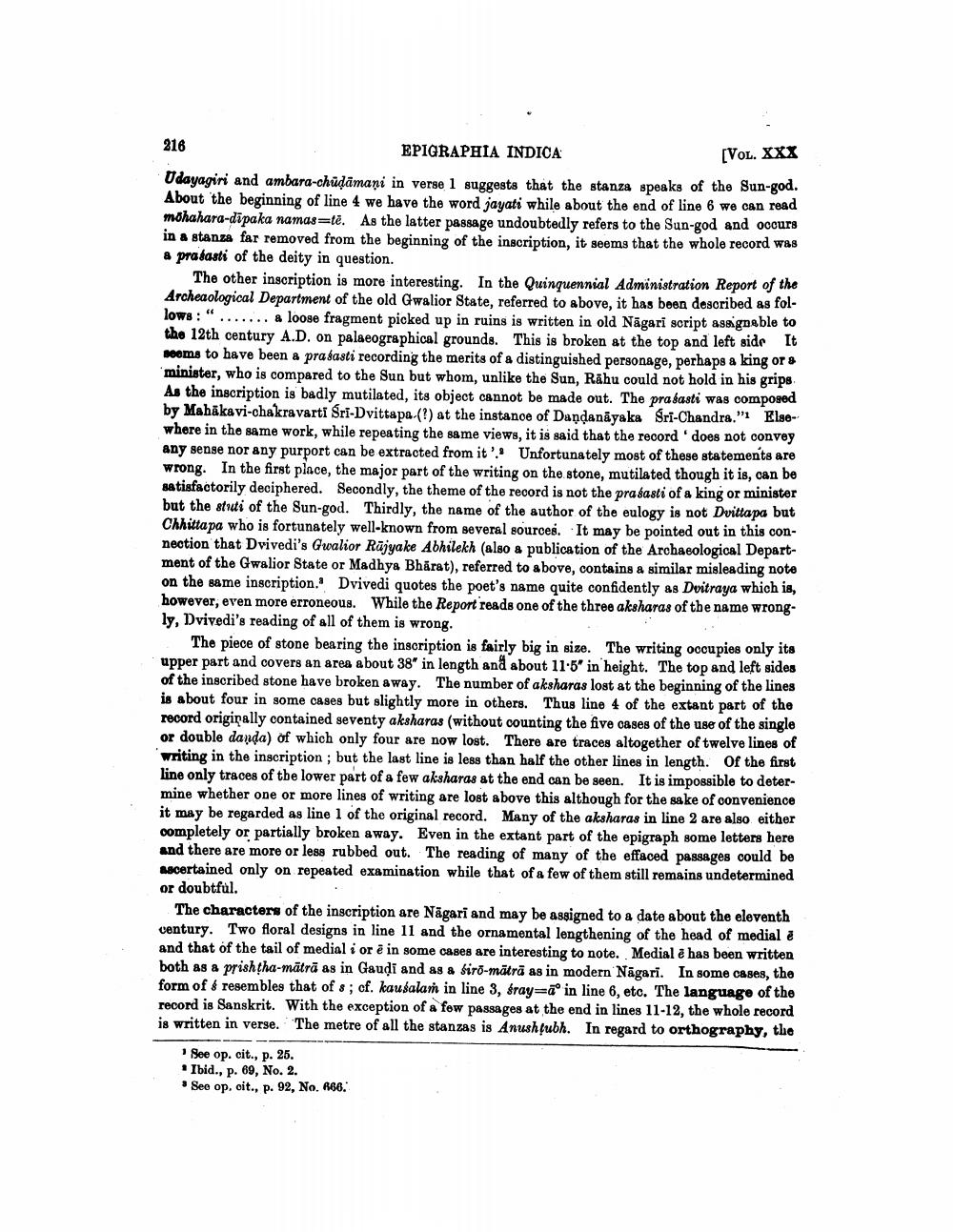________________
216 EPIGRAPHIA INDICA
[VOL. XXX Udayagiri and ambara-chūdāmani in verse 1 suggests that the stanza speaks of the Sun-god. About the beginning of line 4 we have the word jayati while about the end of line 6 we can read mohahara-dīpaka namas=tē. As the latter passage undoubtedly refers to the Sun-god and occurs in a stanza far removed from the beginning of the inscription, it seems that the whole record was a prasasti of the deity in question.
The other inscription is more interesting. In the Quinquennial Administration Report of the Archeaological Department of the old Gwalior State, referred to above, it has been described as follows: "....... a loose fragment picked up in ruins is written in old Nāgari script assignable to the 12th century A.D. on palaeographical grounds. This is broken at the top and left side It rooms to have been a prasasti recording the merits of a distinguished personage, perhaps a king or minister, who is compared to the Sun but whom, unlike the Sun, Rahu could not hold in his grips As the inscription is badly mutilated, its object cannot be made out. The prasasti was composed by Mabākavi-chakravarti Sri-Dvittape (!) at the instance of Dandanayaka Sri-Chandra."! Elsewhere in the same work, while repeating the same views, it is said that the record 'does not convey any sense nor any purport can be extracted from it'. Unfortunately most of these statements are wrong. In the first place, the major part of the writing on the stone, mutilated though it is, can be satisfactorily deciphered. Secondly, the theme of the record is not the prasasti of a king or minister but the struti of the Sun-god. Thirdly, the name of the author of the eulogy is not Dvittapa but Chhittapa who is fortunately well-known from several sources. It may be pointed out in this connection that Dvivedi's Gwalior Rajyake Abhilekh (also a publication of the Archaeological Department of the Gwalior State or Madhya Bharat), referred to above, contains a similar misleading note on the same inscription. Dvivedi quotes the poet's name quite confidently as Dvitraya which is, however, even more erroneous. While the Report reads one of the three aksharas of the name wrongly, Dvivedi's reading of all of them is wrong.
The piece of stone bearing the inscription is fairly big in size. The writing occupies only its upper part and covers an area about 38" in length and about 11.5" in height. The top and left sides of the inscribed stone have broken away. The number of aksharas lost at the beginning of the lines is about four in some cases but slightly more in others. Thus line 4 of the extant part of the record origiņally contained seventy aksharas (without counting the five cases of the use of the single or double danda) of which only four are now lost. There are traces altogether of twelve lines of writing in the inscription ; but the last line is less than half the other lines in length of the first line only traces of the lower part of a few aksharas at the end can be seen. It is impossible to determine whether one or more lines of writing are lost above this although for the sake of convenience it may be regarded as line 1 of the original record. Many of the aksharas in line 2 are also either completely or partially broken away. Even in the extant part of the epigraph some letters here and there are more or less rubbed out. The reading of many of the effaced passages could be Ascertained only on repeated examination while that of a few of them still remains undetermined or doubtful.
The characters of the inscription are Nägari and may be assigned to a date about the eleventh ventury. Two floral designs in line 11 and the ornamental lengthening of the head of medial & and that of the tail of medial i ore in some cases are interesting to note. Medial e has been written both as a prishtha-mātrā as in Gaudi and as a siro-mätra as in modern Nāgari. In some cases, the form of & resembles that of 8; of, kausalan in line 3, sraya in line 6, etc. The language of the record is Sanskrit. With the exception of a few passages at the end in lines 11-12, the whole record is written in verse. The metre of all the stanzas is Anushţubh. In regard to orthography, the
See op. cit., p. 25. * Ibid., p. 69, No. 2. . See op. cit., p. 92, No. 666.




